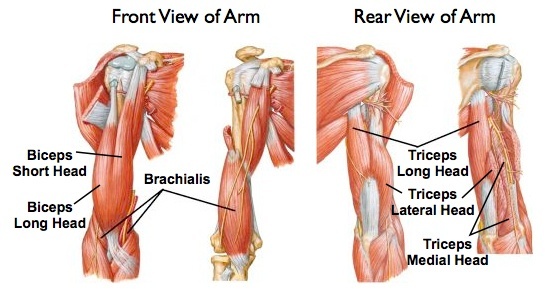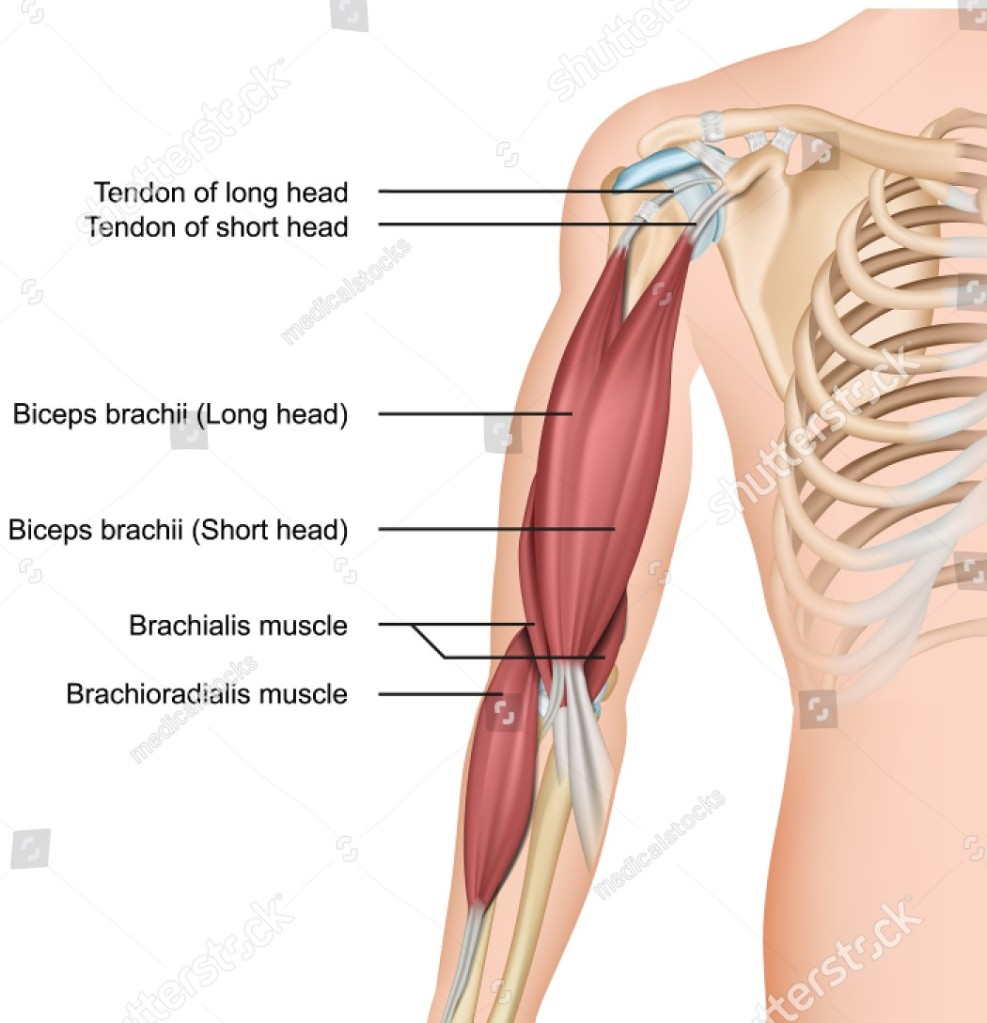What Muscles help with the arms appearance?
Triceps
Take a moment to study the chart below. Notice how the lateral head of the triceps complete’s the smaller (yet sharper) side of the “horshoe” look of the triceps and how it conjoins with the long head completing the shape of the muscle.

Biceps
Then take a look back over at the front view of the arm in the first diagram, then the one bellow for a clearer visual Notice how the brachialis lies just beneath the lower portion of the bicep which is responsible for it’s ”peak” while the long head attatches at the shoulder and wraps all the way outside of the humerus then conjoining with the inner short head of the biceps which connects deep into the elbow pocket which makes up the width of the bicep and completing the biceps brachii.

How Do I Target Them?
Triceps
Directly working only a specific head of the triceps, or any muscle group for that matter, is not entirely possible however they can be more favored thanks to Pickering T Grays Anatomy. 15th ed facsimile (1995) we now understand that other muscles will almost always assist in the completion of a movement pattern. So how does a trainee target all the heads of the tricep we just talked about? well In order to actually shift a greater proportion of effort towards a particular head of the tricep requires training in different leverages, grips, and resistances according to E. Doheny et al (2008). this does not mean that all variations will yield equal results, D. Landinet al (2019) looked into the functions the tricep brachii with in humans and shoulder flexion and how varying angles of degree in shoulder flexion (raising your arms in front of you motion) can be more effective at recruiting the triceps brachii than others. The study showed us the most optimal angle of degree for activating the triceps brachii is 0 to 80 degrees of shoulder flexion with a sweet spot seeming to fall in around 60. This means we want to focus most tricep work within 60-80 degrees of shoulder flexion, utilizing an adjustable bench, adjustable cable column, parallel bars and tricep ropes for safe manipulation of angles and shoulder flexion may be beneficial. In regard to specific training to individual heads such as the lateral and medial, which still make up the triceps brachii and consist of the long head, the lateral head is the one mostly in charged with aesthetic appeal. Going back to our angles, E. Kholinne et al. (2018) explored the individual heads of the triceps brachii and their functional roles depending on shoulder elevation. They found similar results to E. Doheny et al (2016) study in which degrees of 60 – 80 of shoulder flexion were most optimal for activating the triceps however degrees of 80 and beyond transfer more recruitment from the medial and lateral heads of the triceps.
Biceps
As referenced earlier in the discussion on triceps, Pickering T Grays Anatomy. 15th ed facsimile (1995) shows us that while it is not entirely possible to isolate just one, singular head of a muscle, we can still shift the workload to place a heavier emphasis on certain heads by manipulating factors such as grip width, degree of shoulder flexion, and elbow angle. T. Kleiber et al (2015) analyzed various muscle function in the biceps brachii heads according to elbow flexion with a respect to hand position. Their study discovers that neutral and supinated grips both activate equal levels of muscle activity from the biceps brachii as a whole, however using a pronated grip or slightly raising the angle of the elbow during supinated and neutral grip movements will transfer more muscular activity from the brachioradialis (forearms) This finding works not just for the tricep brachii (long, short and medial head) but the biceps brachii (short head, long head, and brachioradialis) as well as we discussed earlier they all work as a system to complete their function, you cannot work one without help of the other. A good example of how effective manipulating these factors was found with T. Kang et al. (2013) In a study for The Journal Of Physical Therapy comparing biceps brachii muscle activity in different angles of the elbow joint (55-90 degrees). Their results revealed significantly higher muscle activation when the subjects elbow was placed at 55 degrees in front of the body than they did in any other elbow angle similarly to D. Landinet al (2019) Study when comparing varying angles of degree in shoulder flexion (0-120) and the functions the tricep brachii takes on. which brings us back to the practical application of adjustable cables, adjustable benches and preacher benches to match the 55 degree elbow elevation angle. Meaning it may be difficult to hold a dumbbell or barbell at that exact angle out in front of the body, this makes preacher, cable and spider curl variants all the more sensible when training our biceps brachii in order to maintain that 55 degree elbow angle in front of the body.
How many reps should I do?
In Part 1 of The Novice Physique Competitors Blueprint, we discover that there is no scientifically superior rep range for muscle growth that dominates the other, C. Mitchell et al. (2012). However there is a variety of muscle fiber types and in order to effectively stimulate all of the different fibers as it may be optimal for trainees to utilize a variety of different rep ranges, thanks to Andrew C Fry (2004) Sports Med. study on the role of muscle fibre adaptations in resistance training. Trainees should decipher this by alternating heavier loads and lighter loads within their bicep and triceps training. An easy way to do this made popular by strength coach Christian Thibaudeau is Wave Loading. Wave Loading can be done by either starting or finishing an exercise with different intensities/weights and reps alternating with each set. example; 1 Set of 5 RM, 1 Set of 8 RM, 1 Set Of 15 RM. This still leaves the volume elephant in the room, to address that we will look into a study by Heaselgrave et al. (2019) which compared optimal training volume between groups who did low (9 Sets), medium (18 sets) and high (27 Sets) weekly volume for the biceps. The study discovered a sweet spot for biceps growth in the medium volume group (18 Weekly Sets) 8.6% greater muscle growth in total compared to the low and high volume groups to be exact.
The Workout
Workout A
- Band Tricep Pushdowns
- Narrow Grip Slight Decline Bench Press
- 3×6/8/10/6/8
- Narrow Grip Chin Up
- 2×7-9
- EZ Bar Curl On Preacher Bench
- 2×12/6
Workout B
- Narrow Grip Rack Chin Up
- Parallel Or V Bar Dips
- Superset: 3×10
- Incline Dumbbell Hammer Curl
- Feet Elevated Narrow Grip Push Up
- Superset: 2×10+
Workout C
- Narrow Grip Slight Decline Bench Press
- Narrow Grip Chin Up
- Superset 2×8
- Rope Triceps Extension
- EZ Bar Curl On Preacher Bench
- 2×10
Have Part 2 Automatically Sent To You Here!
